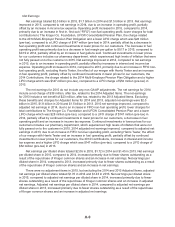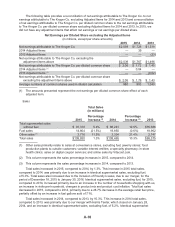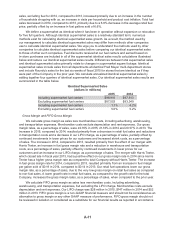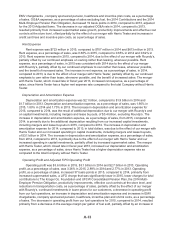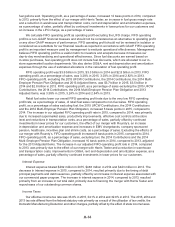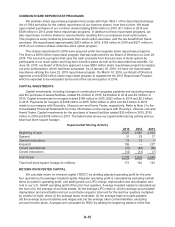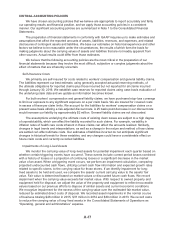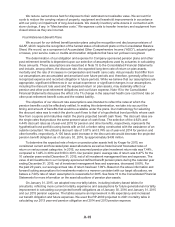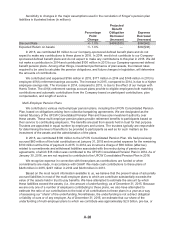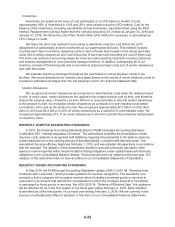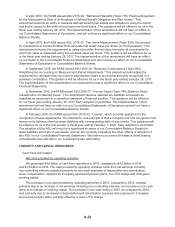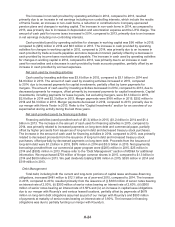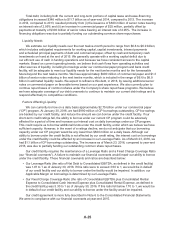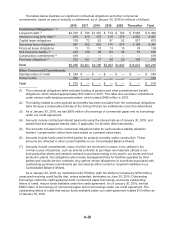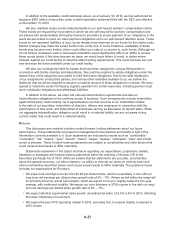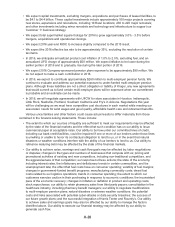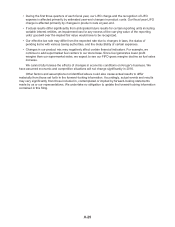Kroger 2015 Annual Report Download - page 93
Download and view the complete annual report
Please find page 93 of the 2015 Kroger annual report below. You can navigate through the pages in the report by either clicking on the pages listed below, or by using the keyword search tool below to find specific information within the annual report.A-19
We reduce owned stores held for disposal to their estimated net realizable value. We account for
costs to reduce the carrying values of property, equipment and leasehold improvements in accordance
with our policy on impairment of long-lived assets. We classify inventory write-downs in connection with
store closings, if any, in “Merchandise costs.” We expense costs to transfer inventory and equipment from
closed stores as they are incurred.
Post-Retirement Benefit Plans
We account for our defined benefit pension plans using the recognition and disclosure provisions of
GAAP, which require the recognition of the funded status of retirement plans on the Consolidated Balance
Sheet. We record, as a component of Accumulated Other Comprehensive Income (“AOCI”), actuarial gains
or losses, prior service costs or credits and transition obligations that have not yet been recognized.
The determination of our obligation and expense for Company-sponsored pension plans and other
post-retirement benefits is dependent upon our selection of assumptions used by actuaries in calculating
those amounts. Those assumptions are described in Note 15 to the Consolidated Financial Statements
and include, among others, the discount rate, the expected long-term rate of return on plan assets,
mortality and the rate of increases in compensation and health care costs. Actual results that differ from
our assumptions are accumulated and amortized over future periods and, therefore, generally affect our
recognized expense and recorded obligation in future periods. While we believe that our assumptions are
appropriate, significant differences in our actual experience or significant changes in our assumptions,
including the discount rate used and the expected return on plan assets, may materially affect our
pension and other post-retirement obligations and our future expense. Note 15 to the Consolidated
Financial Statements discusses the effect of a 1% change in the assumed health care cost trend rate on
other post-retirement benefit costs and the related liability.
The objective of our discount rate assumptions was intended to reflect the rates at which the
pension benefits could be effectively settled. In making this determination, we take into account the
timing and amount of benefits that would be available under the plans. Our methodology for selecting
the discount rates was to match the plan’s cash flows to that of a hypothetical bond portfolio whose cash
flow from coupons and maturities match the plan’s projected benefit cash flows. The discount rates are
the single rates that produce the same present value of cash flows. The selection of the 4.62% and
4.44% discount rates as of year-end 2015 for pension and other benefits, respectively, represents the
hypothetical bond portfolio using bonds with an AA or better rating constructed with the assistance of an
outside consultant. We utilized a discount rate of 3.87% and 3.74% as of year-end 2014 for pension and
other benefits, respectively. A 100 basis point increase in the discount rate would decrease the projected
pension benefit obligation as of January 30, 2016, by approximately $438 million.
To determine the expected rate of return on pension plan assets held by Kroger for 2015, we
considered current and forecasted plan asset allocations as well as historical and forecasted rates of
return on various asset categories. In 2015, our assumed pension plan investment return rate was 7.44%,
compared to 7.44% in 2014 and 8.50 in 2013. Our pension plans’ average rate of return was 6.47% for the
10 calendar years ended December 31, 2015, net of all investment management fees and expenses. The
value of all investments in our Company-sponsored defined benefit pension plans during the calendar year
ending December 31, 2015, net of investment management fees and expenses, decreased 0.80%. For
the past 20 years, our average annual rate of return has been 7.99%. Based on the above information and
forward looking assumptions for investments made in a manner consistent with our target allocations, we
believe a 7.44% rate of return assumption is reasonable for 2015. See Note 15 to the Consolidated Financial
Statements for more information on the asset allocations of pension plan assets.
On January 31, 2015, we adopted new mortality tables, including industry-based tables for
annuitants, reflecting more current mortality experience and assumptions for future generational mortality
improvement in calculating our projected benefit obligations as of January 30, 2016 and January 31, 2015
and our 2015 pension expense. The tables assume an improvement in life expectancy and increased
our benefit obligation and future expenses. We used the RP-2000 projected to 2021 mortality table in
calculating our 2013 year end pension obligation and 2014 and 2013 pension expense.


